Comprehensive Analysis: System Thinking and Project Management
VerifiedAdded on 2023/01/19
|11
|3026
|56
Report
AI Summary
This report delves into the crucial aspects of system thinking and project management, emphasizing their significance in modern organizational contexts. It begins with an introduction to system thinking, highlighting its role in project management, and then progresses to explore organizational structures, risk management strategies, and portfolio management techniques. The report further examines business value creation, organizational maturity models, and their impact on project success. It also covers topics such as engineering risk, risk impact matrix, and the different types of risks. The report also discusses project alignment, business value, and organizational maturity. The conclusion emphasizes the importance of system thinking in addressing complex project challenges, improving communication, and managing risks. The report aims to provide a comprehensive understanding of how system thinking can be applied to improve project outcomes.
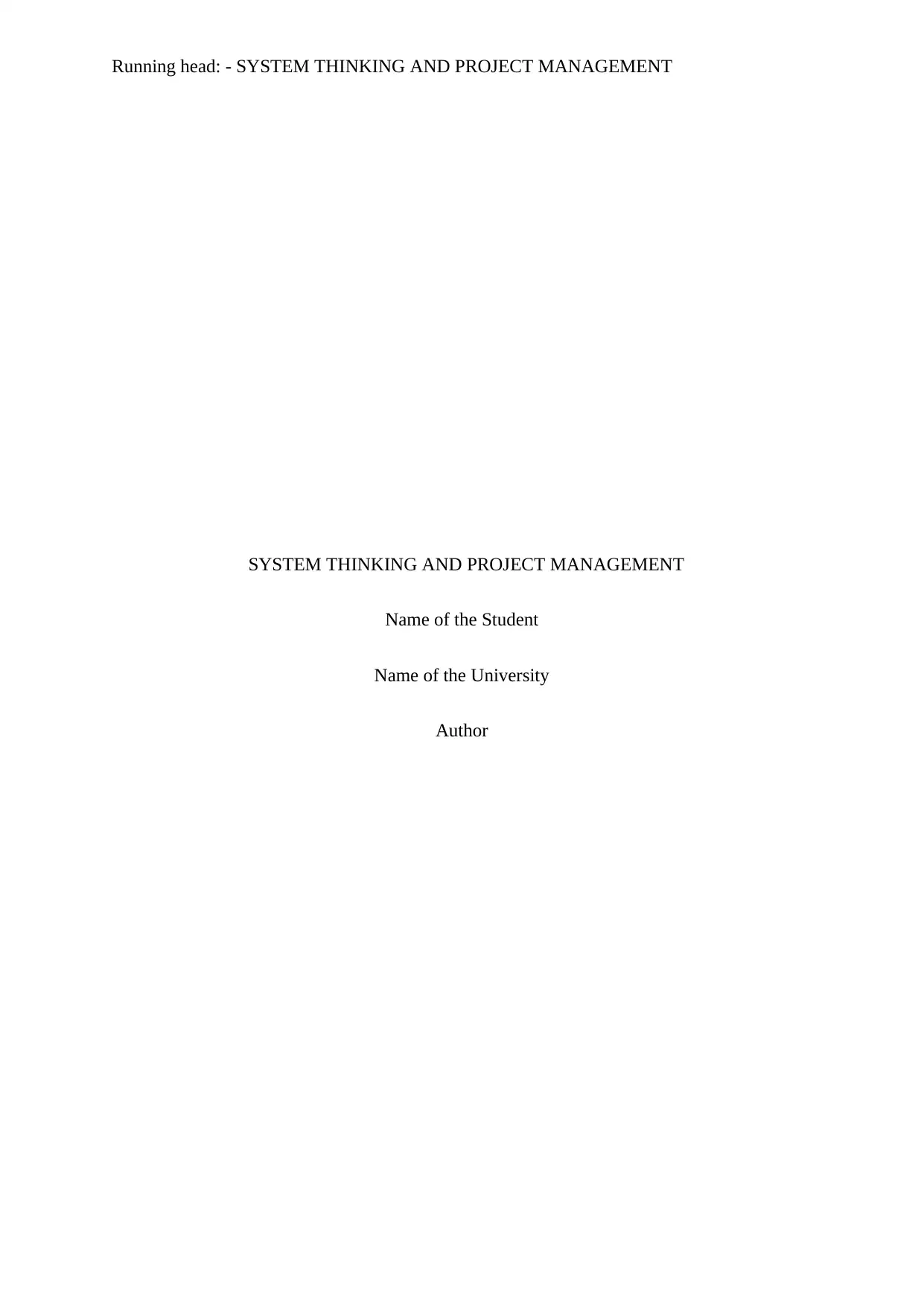
Running head: - SYSTEM THINKING AND PROJECT MANAGEMENT
SYSTEM THINKING AND PROJECT MANAGEMENT
Name of the Student
Name of the University
Author
SYSTEM THINKING AND PROJECT MANAGEMENT
Name of the Student
Name of the University
Author
Paraphrase This Document
Need a fresh take? Get an instant paraphrase of this document with our AI Paraphraser
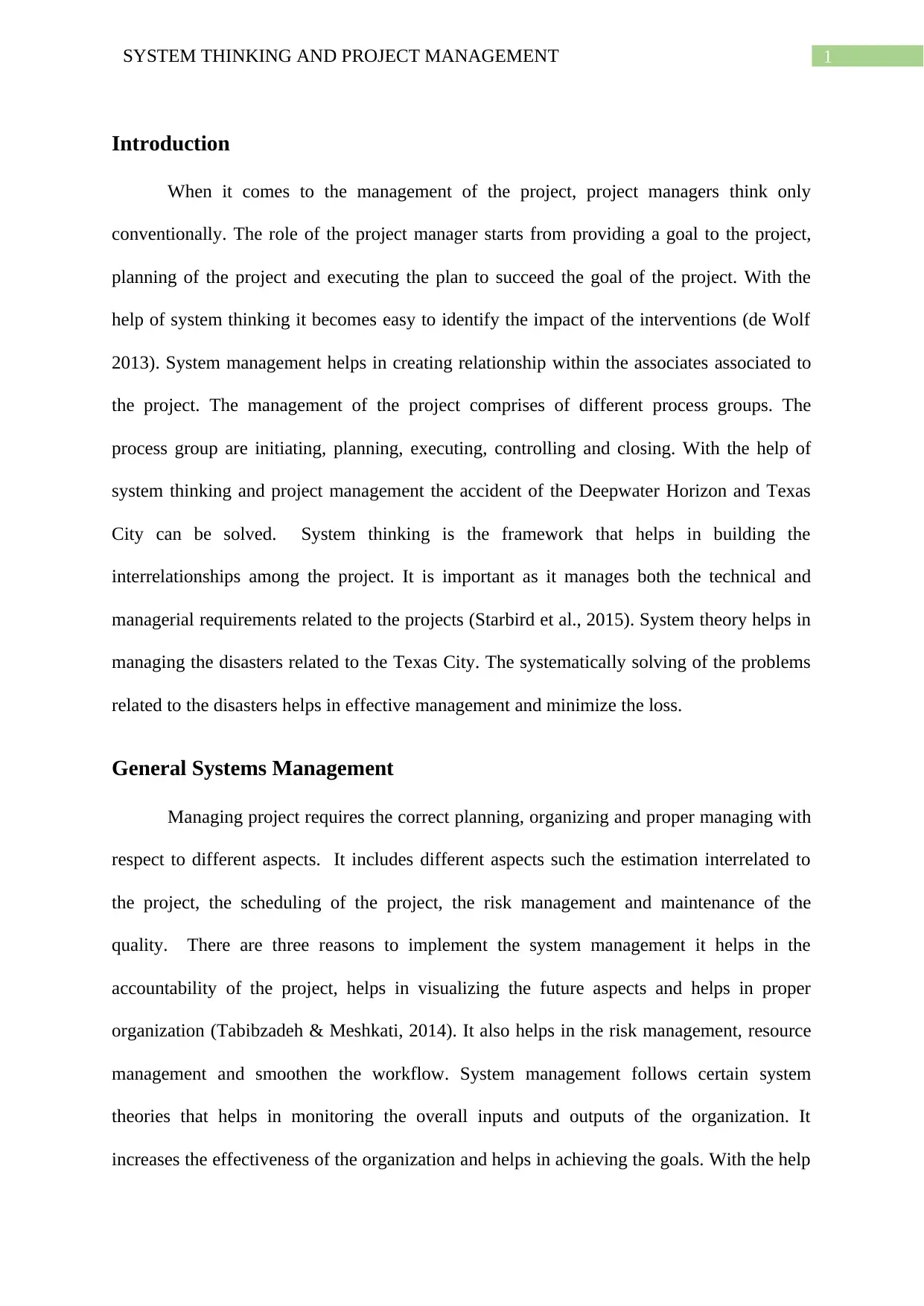
1SYSTEM THINKING AND PROJECT MANAGEMENT
Introduction
When it comes to the management of the project, project managers think only
conventionally. The role of the project manager starts from providing a goal to the project,
planning of the project and executing the plan to succeed the goal of the project. With the
help of system thinking it becomes easy to identify the impact of the interventions (de Wolf
2013). System management helps in creating relationship within the associates associated to
the project. The management of the project comprises of different process groups. The
process group are initiating, planning, executing, controlling and closing. With the help of
system thinking and project management the accident of the Deepwater Horizon and Texas
City can be solved. System thinking is the framework that helps in building the
interrelationships among the project. It is important as it manages both the technical and
managerial requirements related to the projects (Starbird et al., 2015). System theory helps in
managing the disasters related to the Texas City. The systematically solving of the problems
related to the disasters helps in effective management and minimize the loss.
General Systems Management
Managing project requires the correct planning, organizing and proper managing with
respect to different aspects. It includes different aspects such the estimation interrelated to
the project, the scheduling of the project, the risk management and maintenance of the
quality. There are three reasons to implement the system management it helps in the
accountability of the project, helps in visualizing the future aspects and helps in proper
organization (Tabibzadeh & Meshkati, 2014). It also helps in the risk management, resource
management and smoothen the workflow. System management follows certain system
theories that helps in monitoring the overall inputs and outputs of the organization. It
increases the effectiveness of the organization and helps in achieving the goals. With the help
Introduction
When it comes to the management of the project, project managers think only
conventionally. The role of the project manager starts from providing a goal to the project,
planning of the project and executing the plan to succeed the goal of the project. With the
help of system thinking it becomes easy to identify the impact of the interventions (de Wolf
2013). System management helps in creating relationship within the associates associated to
the project. The management of the project comprises of different process groups. The
process group are initiating, planning, executing, controlling and closing. With the help of
system thinking and project management the accident of the Deepwater Horizon and Texas
City can be solved. System thinking is the framework that helps in building the
interrelationships among the project. It is important as it manages both the technical and
managerial requirements related to the projects (Starbird et al., 2015). System theory helps in
managing the disasters related to the Texas City. The systematically solving of the problems
related to the disasters helps in effective management and minimize the loss.
General Systems Management
Managing project requires the correct planning, organizing and proper managing with
respect to different aspects. It includes different aspects such the estimation interrelated to
the project, the scheduling of the project, the risk management and maintenance of the
quality. There are three reasons to implement the system management it helps in the
accountability of the project, helps in visualizing the future aspects and helps in proper
organization (Tabibzadeh & Meshkati, 2014). It also helps in the risk management, resource
management and smoothen the workflow. System management follows certain system
theories that helps in monitoring the overall inputs and outputs of the organization. It
increases the effectiveness of the organization and helps in achieving the goals. With the help
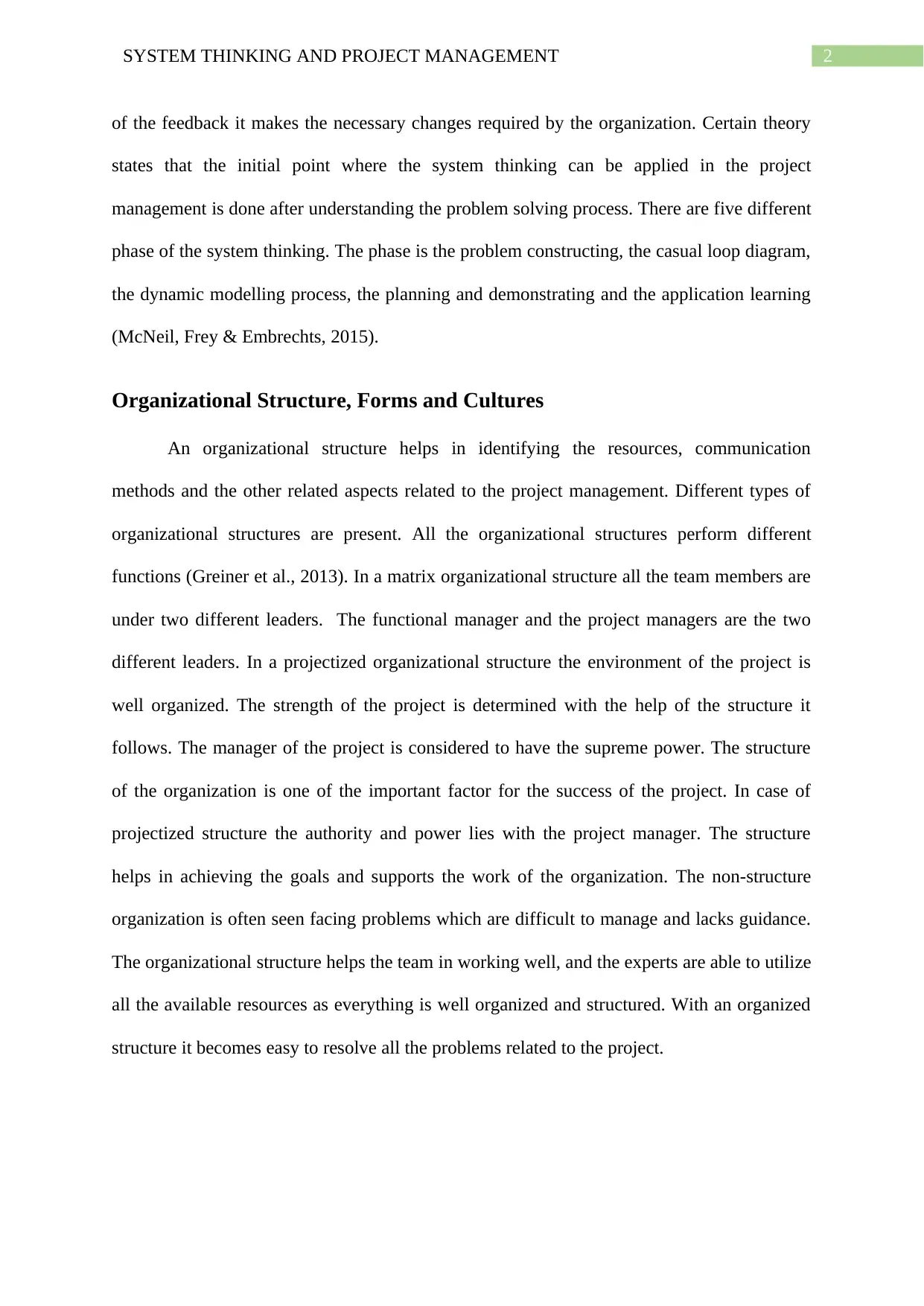
2SYSTEM THINKING AND PROJECT MANAGEMENT
of the feedback it makes the necessary changes required by the organization. Certain theory
states that the initial point where the system thinking can be applied in the project
management is done after understanding the problem solving process. There are five different
phase of the system thinking. The phase is the problem constructing, the casual loop diagram,
the dynamic modelling process, the planning and demonstrating and the application learning
(McNeil, Frey & Embrechts, 2015).
Organizational Structure, Forms and Cultures
An organizational structure helps in identifying the resources, communication
methods and the other related aspects related to the project management. Different types of
organizational structures are present. All the organizational structures perform different
functions (Greiner et al., 2013). In a matrix organizational structure all the team members are
under two different leaders. The functional manager and the project managers are the two
different leaders. In a projectized organizational structure the environment of the project is
well organized. The strength of the project is determined with the help of the structure it
follows. The manager of the project is considered to have the supreme power. The structure
of the organization is one of the important factor for the success of the project. In case of
projectized structure the authority and power lies with the project manager. The structure
helps in achieving the goals and supports the work of the organization. The non-structure
organization is often seen facing problems which are difficult to manage and lacks guidance.
The organizational structure helps the team in working well, and the experts are able to utilize
all the available resources as everything is well organized and structured. With an organized
structure it becomes easy to resolve all the problems related to the project.
of the feedback it makes the necessary changes required by the organization. Certain theory
states that the initial point where the system thinking can be applied in the project
management is done after understanding the problem solving process. There are five different
phase of the system thinking. The phase is the problem constructing, the casual loop diagram,
the dynamic modelling process, the planning and demonstrating and the application learning
(McNeil, Frey & Embrechts, 2015).
Organizational Structure, Forms and Cultures
An organizational structure helps in identifying the resources, communication
methods and the other related aspects related to the project management. Different types of
organizational structures are present. All the organizational structures perform different
functions (Greiner et al., 2013). In a matrix organizational structure all the team members are
under two different leaders. The functional manager and the project managers are the two
different leaders. In a projectized organizational structure the environment of the project is
well organized. The strength of the project is determined with the help of the structure it
follows. The manager of the project is considered to have the supreme power. The structure
of the organization is one of the important factor for the success of the project. In case of
projectized structure the authority and power lies with the project manager. The structure
helps in achieving the goals and supports the work of the organization. The non-structure
organization is often seen facing problems which are difficult to manage and lacks guidance.
The organizational structure helps the team in working well, and the experts are able to utilize
all the available resources as everything is well organized and structured. With an organized
structure it becomes easy to resolve all the problems related to the project.
⊘ This is a preview!⊘
Do you want full access?
Subscribe today to unlock all pages.

Trusted by 1+ million students worldwide
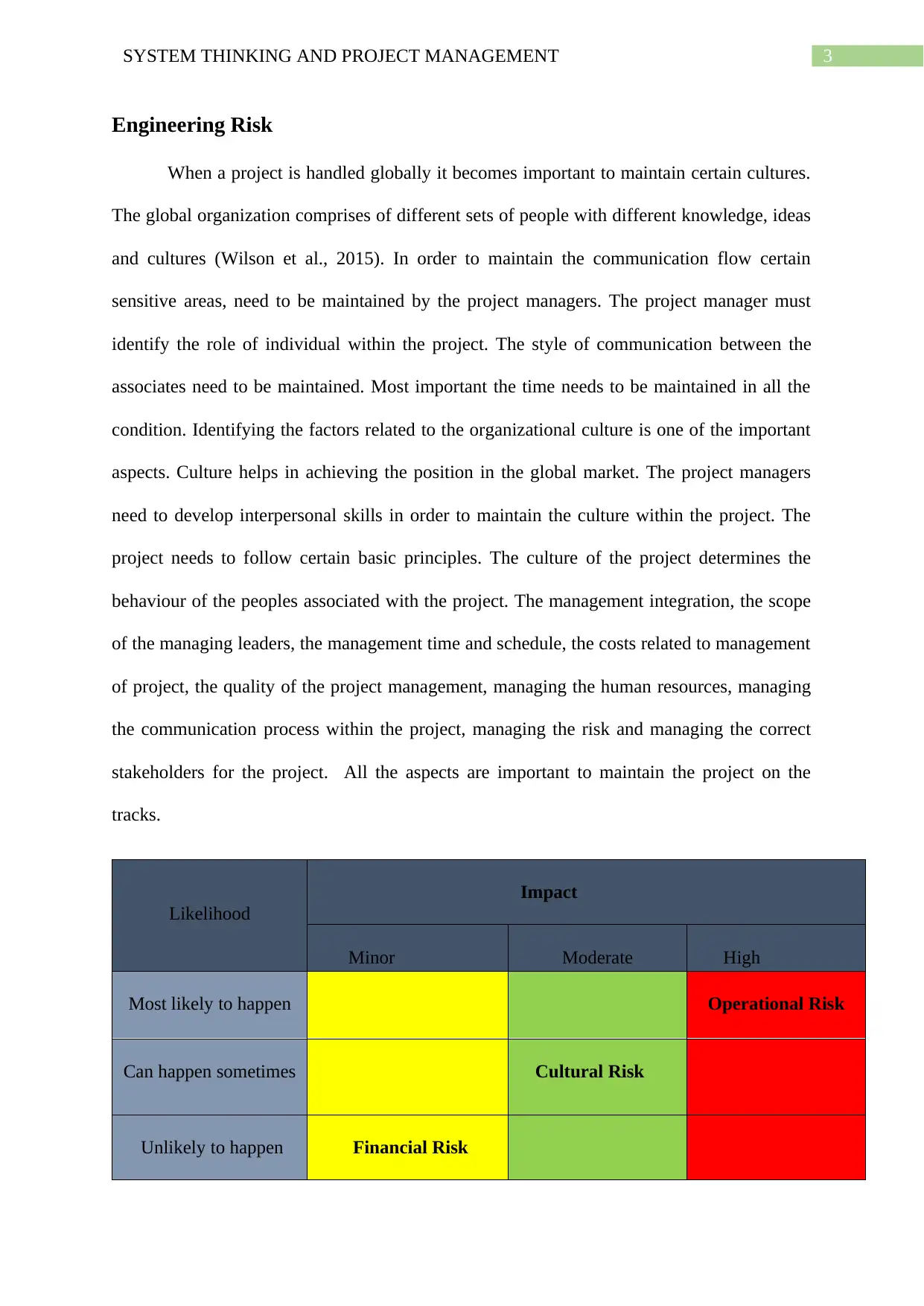
3SYSTEM THINKING AND PROJECT MANAGEMENT
Engineering Risk
When a project is handled globally it becomes important to maintain certain cultures.
The global organization comprises of different sets of people with different knowledge, ideas
and cultures (Wilson et al., 2015). In order to maintain the communication flow certain
sensitive areas, need to be maintained by the project managers. The project manager must
identify the role of individual within the project. The style of communication between the
associates need to be maintained. Most important the time needs to be maintained in all the
condition. Identifying the factors related to the organizational culture is one of the important
aspects. Culture helps in achieving the position in the global market. The project managers
need to develop interpersonal skills in order to maintain the culture within the project. The
project needs to follow certain basic principles. The culture of the project determines the
behaviour of the peoples associated with the project. The management integration, the scope
of the managing leaders, the management time and schedule, the costs related to management
of project, the quality of the project management, managing the human resources, managing
the communication process within the project, managing the risk and managing the correct
stakeholders for the project. All the aspects are important to maintain the project on the
tracks.
Likelihood
Impact
Minor Moderate High
Most likely to happen Operational Risk
Can happen sometimes Cultural Risk
Unlikely to happen Financial Risk
Engineering Risk
When a project is handled globally it becomes important to maintain certain cultures.
The global organization comprises of different sets of people with different knowledge, ideas
and cultures (Wilson et al., 2015). In order to maintain the communication flow certain
sensitive areas, need to be maintained by the project managers. The project manager must
identify the role of individual within the project. The style of communication between the
associates need to be maintained. Most important the time needs to be maintained in all the
condition. Identifying the factors related to the organizational culture is one of the important
aspects. Culture helps in achieving the position in the global market. The project managers
need to develop interpersonal skills in order to maintain the culture within the project. The
project needs to follow certain basic principles. The culture of the project determines the
behaviour of the peoples associated with the project. The management integration, the scope
of the managing leaders, the management time and schedule, the costs related to management
of project, the quality of the project management, managing the human resources, managing
the communication process within the project, managing the risk and managing the correct
stakeholders for the project. All the aspects are important to maintain the project on the
tracks.
Likelihood
Impact
Minor Moderate High
Most likely to happen Operational Risk
Can happen sometimes Cultural Risk
Unlikely to happen Financial Risk
Paraphrase This Document
Need a fresh take? Get an instant paraphrase of this document with our AI Paraphraser
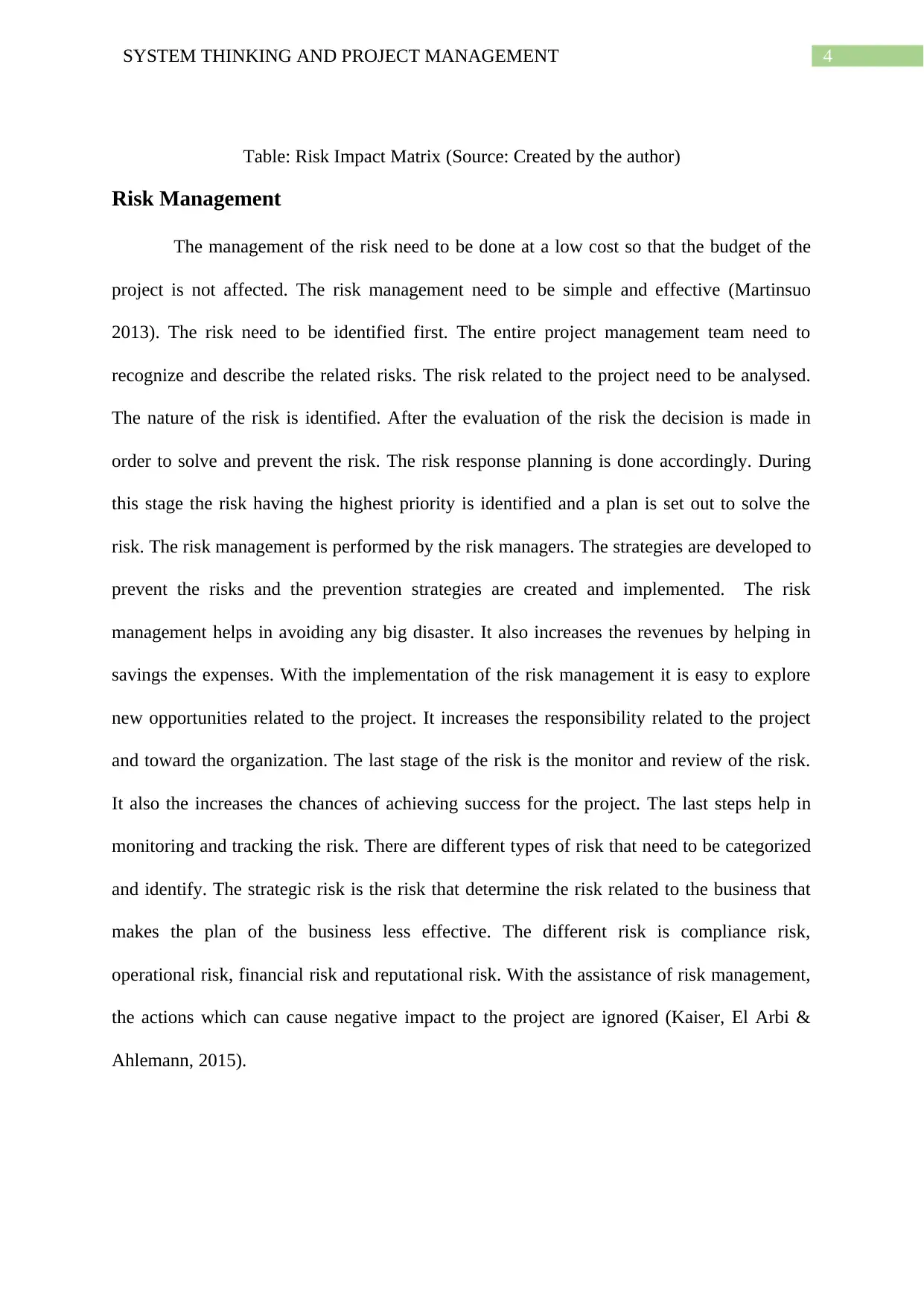
4SYSTEM THINKING AND PROJECT MANAGEMENT
Table: Risk Impact Matrix (Source: Created by the author)
Risk Management
The management of the risk need to be done at a low cost so that the budget of the
project is not affected. The risk management need to be simple and effective (Martinsuo
2013). The risk need to be identified first. The entire project management team need to
recognize and describe the related risks. The risk related to the project need to be analysed.
The nature of the risk is identified. After the evaluation of the risk the decision is made in
order to solve and prevent the risk. The risk response planning is done accordingly. During
this stage the risk having the highest priority is identified and a plan is set out to solve the
risk. The risk management is performed by the risk managers. The strategies are developed to
prevent the risks and the prevention strategies are created and implemented. The risk
management helps in avoiding any big disaster. It also increases the revenues by helping in
savings the expenses. With the implementation of the risk management it is easy to explore
new opportunities related to the project. It increases the responsibility related to the project
and toward the organization. The last stage of the risk is the monitor and review of the risk.
It also the increases the chances of achieving success for the project. The last steps help in
monitoring and tracking the risk. There are different types of risk that need to be categorized
and identify. The strategic risk is the risk that determine the risk related to the business that
makes the plan of the business less effective. The different risk is compliance risk,
operational risk, financial risk and reputational risk. With the assistance of risk management,
the actions which can cause negative impact to the project are ignored (Kaiser, El Arbi &
Ahlemann, 2015).
Table: Risk Impact Matrix (Source: Created by the author)
Risk Management
The management of the risk need to be done at a low cost so that the budget of the
project is not affected. The risk management need to be simple and effective (Martinsuo
2013). The risk need to be identified first. The entire project management team need to
recognize and describe the related risks. The risk related to the project need to be analysed.
The nature of the risk is identified. After the evaluation of the risk the decision is made in
order to solve and prevent the risk. The risk response planning is done accordingly. During
this stage the risk having the highest priority is identified and a plan is set out to solve the
risk. The risk management is performed by the risk managers. The strategies are developed to
prevent the risks and the prevention strategies are created and implemented. The risk
management helps in avoiding any big disaster. It also increases the revenues by helping in
savings the expenses. With the implementation of the risk management it is easy to explore
new opportunities related to the project. It increases the responsibility related to the project
and toward the organization. The last stage of the risk is the monitor and review of the risk.
It also the increases the chances of achieving success for the project. The last steps help in
monitoring and tracking the risk. There are different types of risk that need to be categorized
and identify. The strategic risk is the risk that determine the risk related to the business that
makes the plan of the business less effective. The different risk is compliance risk,
operational risk, financial risk and reputational risk. With the assistance of risk management,
the actions which can cause negative impact to the project are ignored (Kaiser, El Arbi &
Ahlemann, 2015).
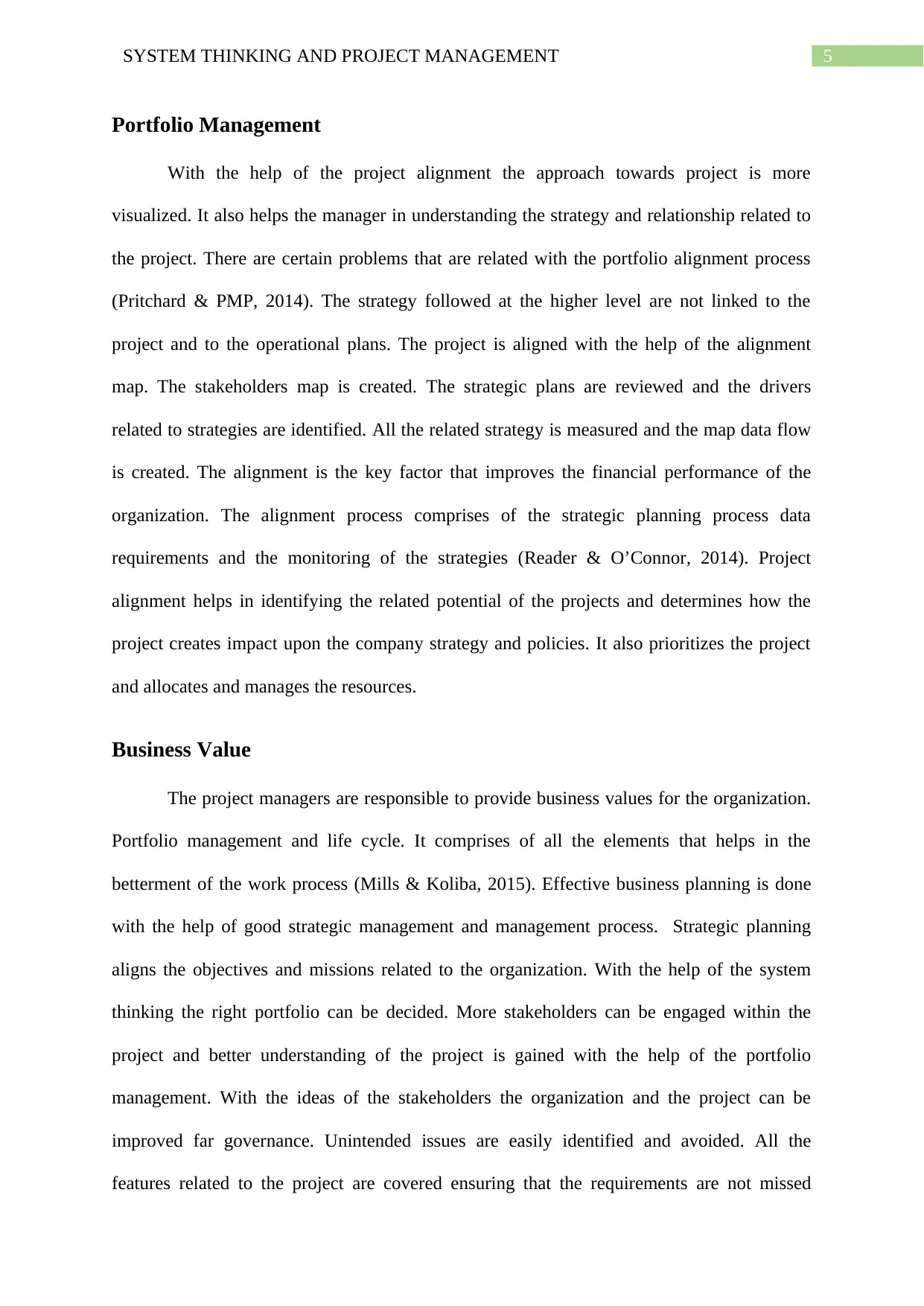
5SYSTEM THINKING AND PROJECT MANAGEMENT
Portfolio Management
With the help of the project alignment the approach towards project is more
visualized. It also helps the manager in understanding the strategy and relationship related to
the project. There are certain problems that are related with the portfolio alignment process
(Pritchard & PMP, 2014). The strategy followed at the higher level are not linked to the
project and to the operational plans. The project is aligned with the help of the alignment
map. The stakeholders map is created. The strategic plans are reviewed and the drivers
related to strategies are identified. All the related strategy is measured and the map data flow
is created. The alignment is the key factor that improves the financial performance of the
organization. The alignment process comprises of the strategic planning process data
requirements and the monitoring of the strategies (Reader & O’Connor, 2014). Project
alignment helps in identifying the related potential of the projects and determines how the
project creates impact upon the company strategy and policies. It also prioritizes the project
and allocates and manages the resources.
Business Value
The project managers are responsible to provide business values for the organization.
Portfolio management and life cycle. It comprises of all the elements that helps in the
betterment of the work process (Mills & Koliba, 2015). Effective business planning is done
with the help of good strategic management and management process. Strategic planning
aligns the objectives and missions related to the organization. With the help of the system
thinking the right portfolio can be decided. More stakeholders can be engaged within the
project and better understanding of the project is gained with the help of the portfolio
management. With the ideas of the stakeholders the organization and the project can be
improved far governance. Unintended issues are easily identified and avoided. All the
features related to the project are covered ensuring that the requirements are not missed
Portfolio Management
With the help of the project alignment the approach towards project is more
visualized. It also helps the manager in understanding the strategy and relationship related to
the project. There are certain problems that are related with the portfolio alignment process
(Pritchard & PMP, 2014). The strategy followed at the higher level are not linked to the
project and to the operational plans. The project is aligned with the help of the alignment
map. The stakeholders map is created. The strategic plans are reviewed and the drivers
related to strategies are identified. All the related strategy is measured and the map data flow
is created. The alignment is the key factor that improves the financial performance of the
organization. The alignment process comprises of the strategic planning process data
requirements and the monitoring of the strategies (Reader & O’Connor, 2014). Project
alignment helps in identifying the related potential of the projects and determines how the
project creates impact upon the company strategy and policies. It also prioritizes the project
and allocates and manages the resources.
Business Value
The project managers are responsible to provide business values for the organization.
Portfolio management and life cycle. It comprises of all the elements that helps in the
betterment of the work process (Mills & Koliba, 2015). Effective business planning is done
with the help of good strategic management and management process. Strategic planning
aligns the objectives and missions related to the organization. With the help of the system
thinking the right portfolio can be decided. More stakeholders can be engaged within the
project and better understanding of the project is gained with the help of the portfolio
management. With the ideas of the stakeholders the organization and the project can be
improved far governance. Unintended issues are easily identified and avoided. All the
features related to the project are covered ensuring that the requirements are not missed
⊘ This is a preview!⊘
Do you want full access?
Subscribe today to unlock all pages.

Trusted by 1+ million students worldwide
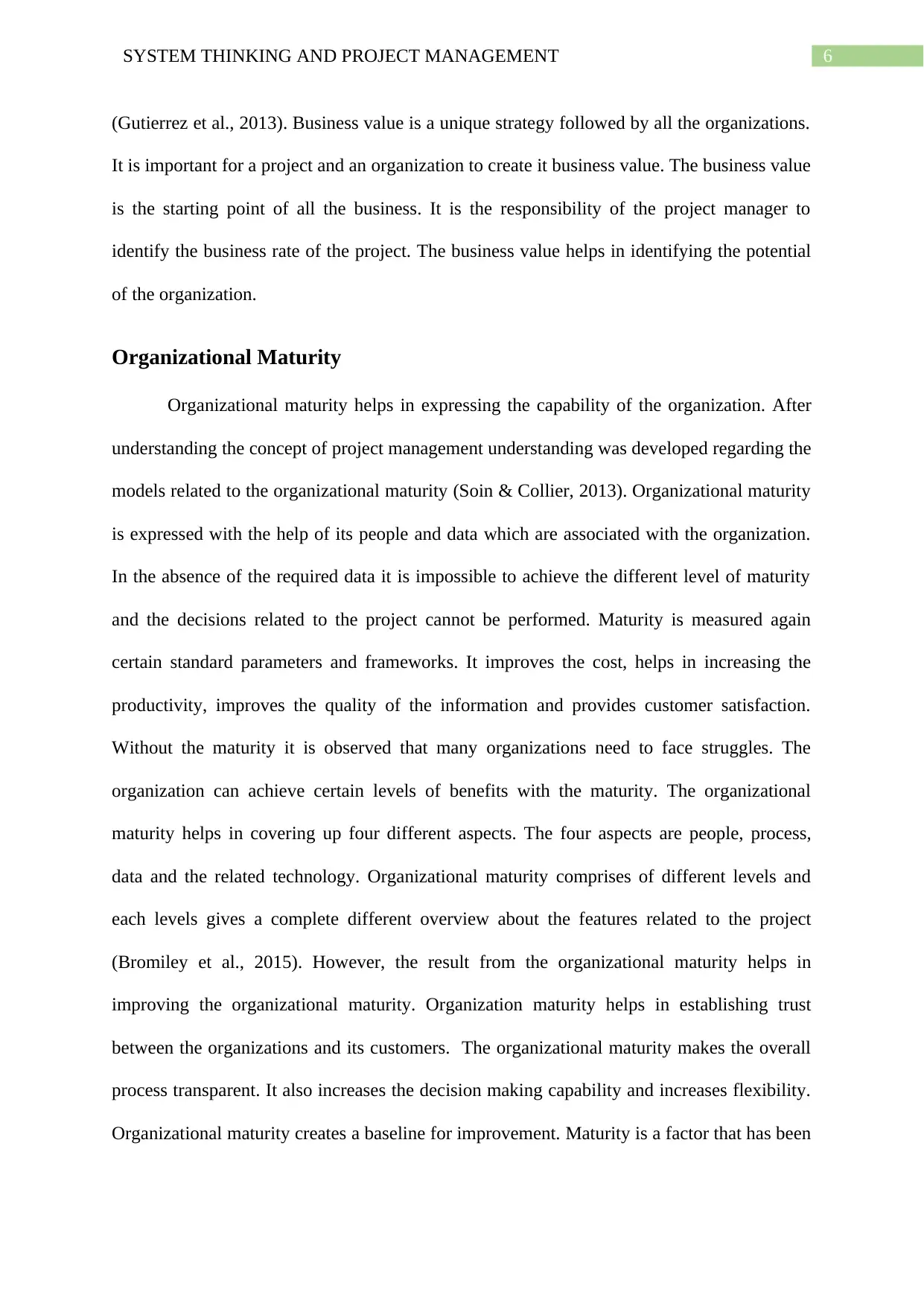
6SYSTEM THINKING AND PROJECT MANAGEMENT
(Gutierrez et al., 2013). Business value is a unique strategy followed by all the organizations.
It is important for a project and an organization to create it business value. The business value
is the starting point of all the business. It is the responsibility of the project manager to
identify the business rate of the project. The business value helps in identifying the potential
of the organization.
Organizational Maturity
Organizational maturity helps in expressing the capability of the organization. After
understanding the concept of project management understanding was developed regarding the
models related to the organizational maturity (Soin & Collier, 2013). Organizational maturity
is expressed with the help of its people and data which are associated with the organization.
In the absence of the required data it is impossible to achieve the different level of maturity
and the decisions related to the project cannot be performed. Maturity is measured again
certain standard parameters and frameworks. It improves the cost, helps in increasing the
productivity, improves the quality of the information and provides customer satisfaction.
Without the maturity it is observed that many organizations need to face struggles. The
organization can achieve certain levels of benefits with the maturity. The organizational
maturity helps in covering up four different aspects. The four aspects are people, process,
data and the related technology. Organizational maturity comprises of different levels and
each levels gives a complete different overview about the features related to the project
(Bromiley et al., 2015). However, the result from the organizational maturity helps in
improving the organizational maturity. Organization maturity helps in establishing trust
between the organizations and its customers. The organizational maturity makes the overall
process transparent. It also increases the decision making capability and increases flexibility.
Organizational maturity creates a baseline for improvement. Maturity is a factor that has been
(Gutierrez et al., 2013). Business value is a unique strategy followed by all the organizations.
It is important for a project and an organization to create it business value. The business value
is the starting point of all the business. It is the responsibility of the project manager to
identify the business rate of the project. The business value helps in identifying the potential
of the organization.
Organizational Maturity
Organizational maturity helps in expressing the capability of the organization. After
understanding the concept of project management understanding was developed regarding the
models related to the organizational maturity (Soin & Collier, 2013). Organizational maturity
is expressed with the help of its people and data which are associated with the organization.
In the absence of the required data it is impossible to achieve the different level of maturity
and the decisions related to the project cannot be performed. Maturity is measured again
certain standard parameters and frameworks. It improves the cost, helps in increasing the
productivity, improves the quality of the information and provides customer satisfaction.
Without the maturity it is observed that many organizations need to face struggles. The
organization can achieve certain levels of benefits with the maturity. The organizational
maturity helps in covering up four different aspects. The four aspects are people, process,
data and the related technology. Organizational maturity comprises of different levels and
each levels gives a complete different overview about the features related to the project
(Bromiley et al., 2015). However, the result from the organizational maturity helps in
improving the organizational maturity. Organization maturity helps in establishing trust
between the organizations and its customers. The organizational maturity makes the overall
process transparent. It also increases the decision making capability and increases flexibility.
Organizational maturity creates a baseline for improvement. Maturity is a factor that has been
Paraphrase This Document
Need a fresh take? Get an instant paraphrase of this document with our AI Paraphraser
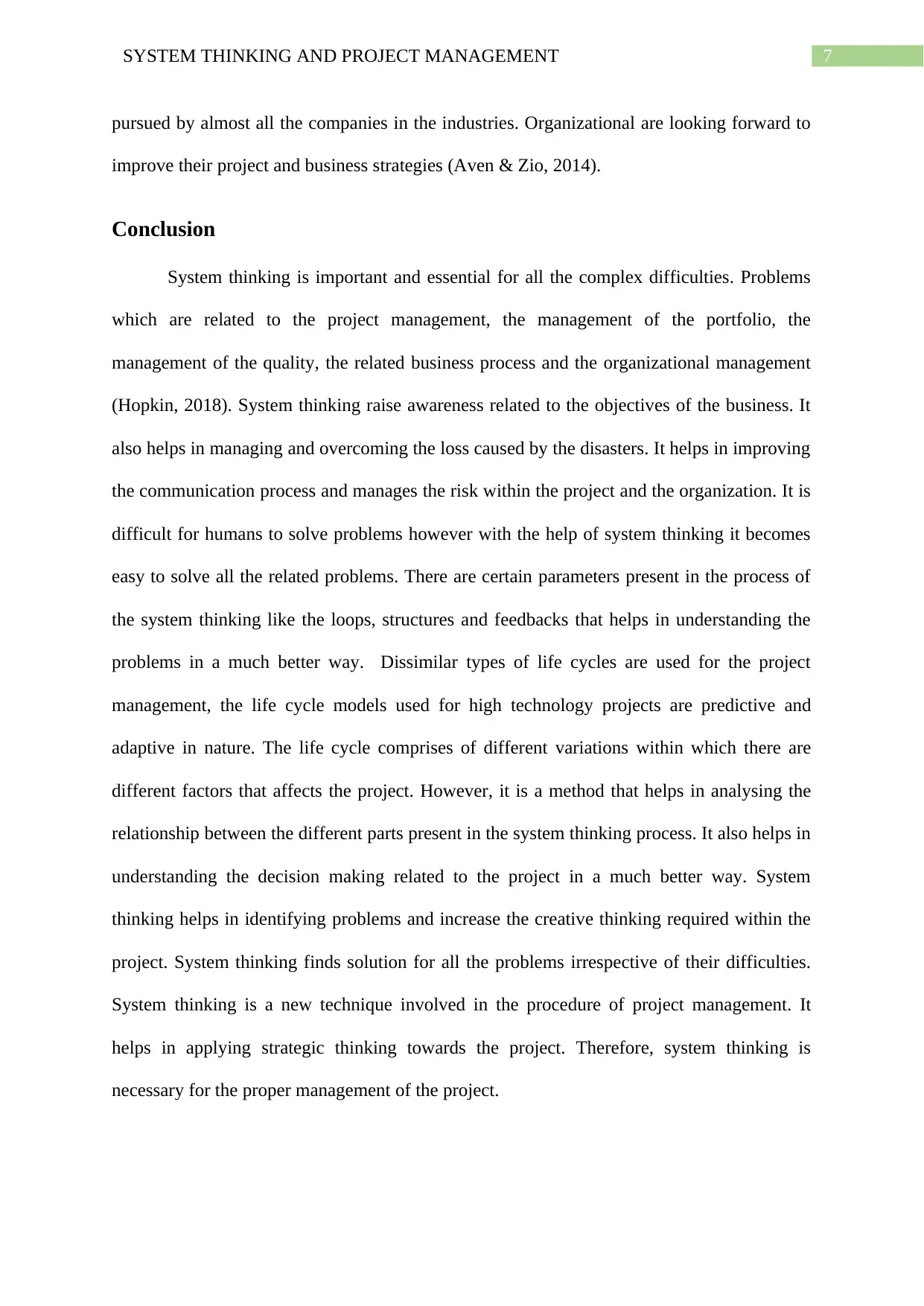
7SYSTEM THINKING AND PROJECT MANAGEMENT
pursued by almost all the companies in the industries. Organizational are looking forward to
improve their project and business strategies (Aven & Zio, 2014).
Conclusion
System thinking is important and essential for all the complex difficulties. Problems
which are related to the project management, the management of the portfolio, the
management of the quality, the related business process and the organizational management
(Hopkin, 2018). System thinking raise awareness related to the objectives of the business. It
also helps in managing and overcoming the loss caused by the disasters. It helps in improving
the communication process and manages the risk within the project and the organization. It is
difficult for humans to solve problems however with the help of system thinking it becomes
easy to solve all the related problems. There are certain parameters present in the process of
the system thinking like the loops, structures and feedbacks that helps in understanding the
problems in a much better way. Dissimilar types of life cycles are used for the project
management, the life cycle models used for high technology projects are predictive and
adaptive in nature. The life cycle comprises of different variations within which there are
different factors that affects the project. However, it is a method that helps in analysing the
relationship between the different parts present in the system thinking process. It also helps in
understanding the decision making related to the project in a much better way. System
thinking helps in identifying problems and increase the creative thinking required within the
project. System thinking finds solution for all the problems irrespective of their difficulties.
System thinking is a new technique involved in the procedure of project management. It
helps in applying strategic thinking towards the project. Therefore, system thinking is
necessary for the proper management of the project.
pursued by almost all the companies in the industries. Organizational are looking forward to
improve their project and business strategies (Aven & Zio, 2014).
Conclusion
System thinking is important and essential for all the complex difficulties. Problems
which are related to the project management, the management of the portfolio, the
management of the quality, the related business process and the organizational management
(Hopkin, 2018). System thinking raise awareness related to the objectives of the business. It
also helps in managing and overcoming the loss caused by the disasters. It helps in improving
the communication process and manages the risk within the project and the organization. It is
difficult for humans to solve problems however with the help of system thinking it becomes
easy to solve all the related problems. There are certain parameters present in the process of
the system thinking like the loops, structures and feedbacks that helps in understanding the
problems in a much better way. Dissimilar types of life cycles are used for the project
management, the life cycle models used for high technology projects are predictive and
adaptive in nature. The life cycle comprises of different variations within which there are
different factors that affects the project. However, it is a method that helps in analysing the
relationship between the different parts present in the system thinking process. It also helps in
understanding the decision making related to the project in a much better way. System
thinking helps in identifying problems and increase the creative thinking required within the
project. System thinking finds solution for all the problems irrespective of their difficulties.
System thinking is a new technique involved in the procedure of project management. It
helps in applying strategic thinking towards the project. Therefore, system thinking is
necessary for the proper management of the project.
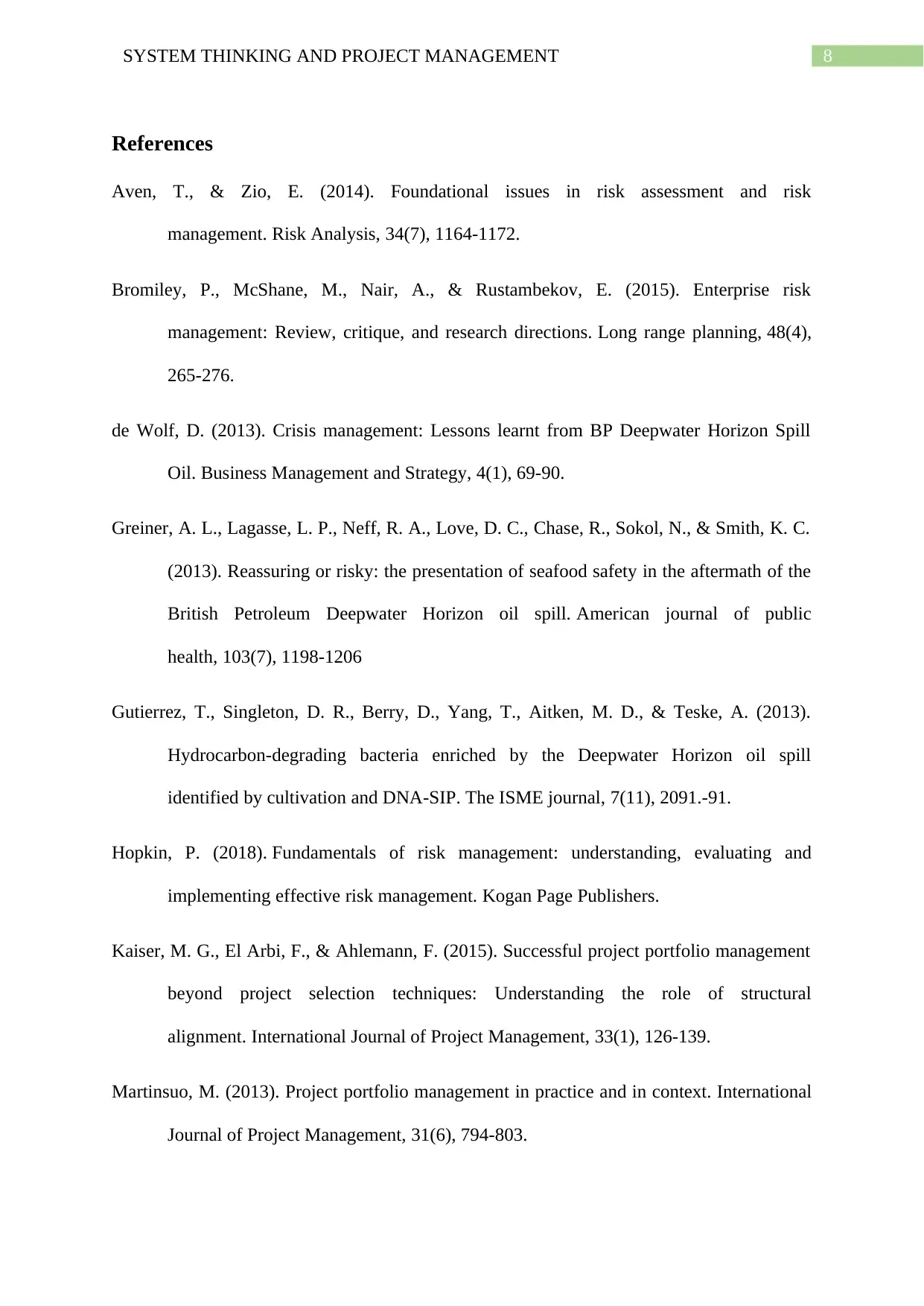
8SYSTEM THINKING AND PROJECT MANAGEMENT
References
Aven, T., & Zio, E. (2014). Foundational issues in risk assessment and risk
management. Risk Analysis, 34(7), 1164-1172.
Bromiley, P., McShane, M., Nair, A., & Rustambekov, E. (2015). Enterprise risk
management: Review, critique, and research directions. Long range planning, 48(4),
265-276.
de Wolf, D. (2013). Crisis management: Lessons learnt from BP Deepwater Horizon Spill
Oil. Business Management and Strategy, 4(1), 69-90.
Greiner, A. L., Lagasse, L. P., Neff, R. A., Love, D. C., Chase, R., Sokol, N., & Smith, K. C.
(2013). Reassuring or risky: the presentation of seafood safety in the aftermath of the
British Petroleum Deepwater Horizon oil spill. American journal of public
health, 103(7), 1198-1206
Gutierrez, T., Singleton, D. R., Berry, D., Yang, T., Aitken, M. D., & Teske, A. (2013).
Hydrocarbon-degrading bacteria enriched by the Deepwater Horizon oil spill
identified by cultivation and DNA-SIP. The ISME journal, 7(11), 2091.-91.
Hopkin, P. (2018). Fundamentals of risk management: understanding, evaluating and
implementing effective risk management. Kogan Page Publishers.
Kaiser, M. G., El Arbi, F., & Ahlemann, F. (2015). Successful project portfolio management
beyond project selection techniques: Understanding the role of structural
alignment. International Journal of Project Management, 33(1), 126-139.
Martinsuo, M. (2013). Project portfolio management in practice and in context. International
Journal of Project Management, 31(6), 794-803.
References
Aven, T., & Zio, E. (2014). Foundational issues in risk assessment and risk
management. Risk Analysis, 34(7), 1164-1172.
Bromiley, P., McShane, M., Nair, A., & Rustambekov, E. (2015). Enterprise risk
management: Review, critique, and research directions. Long range planning, 48(4),
265-276.
de Wolf, D. (2013). Crisis management: Lessons learnt from BP Deepwater Horizon Spill
Oil. Business Management and Strategy, 4(1), 69-90.
Greiner, A. L., Lagasse, L. P., Neff, R. A., Love, D. C., Chase, R., Sokol, N., & Smith, K. C.
(2013). Reassuring or risky: the presentation of seafood safety in the aftermath of the
British Petroleum Deepwater Horizon oil spill. American journal of public
health, 103(7), 1198-1206
Gutierrez, T., Singleton, D. R., Berry, D., Yang, T., Aitken, M. D., & Teske, A. (2013).
Hydrocarbon-degrading bacteria enriched by the Deepwater Horizon oil spill
identified by cultivation and DNA-SIP. The ISME journal, 7(11), 2091.-91.
Hopkin, P. (2018). Fundamentals of risk management: understanding, evaluating and
implementing effective risk management. Kogan Page Publishers.
Kaiser, M. G., El Arbi, F., & Ahlemann, F. (2015). Successful project portfolio management
beyond project selection techniques: Understanding the role of structural
alignment. International Journal of Project Management, 33(1), 126-139.
Martinsuo, M. (2013). Project portfolio management in practice and in context. International
Journal of Project Management, 31(6), 794-803.
⊘ This is a preview!⊘
Do you want full access?
Subscribe today to unlock all pages.

Trusted by 1+ million students worldwide
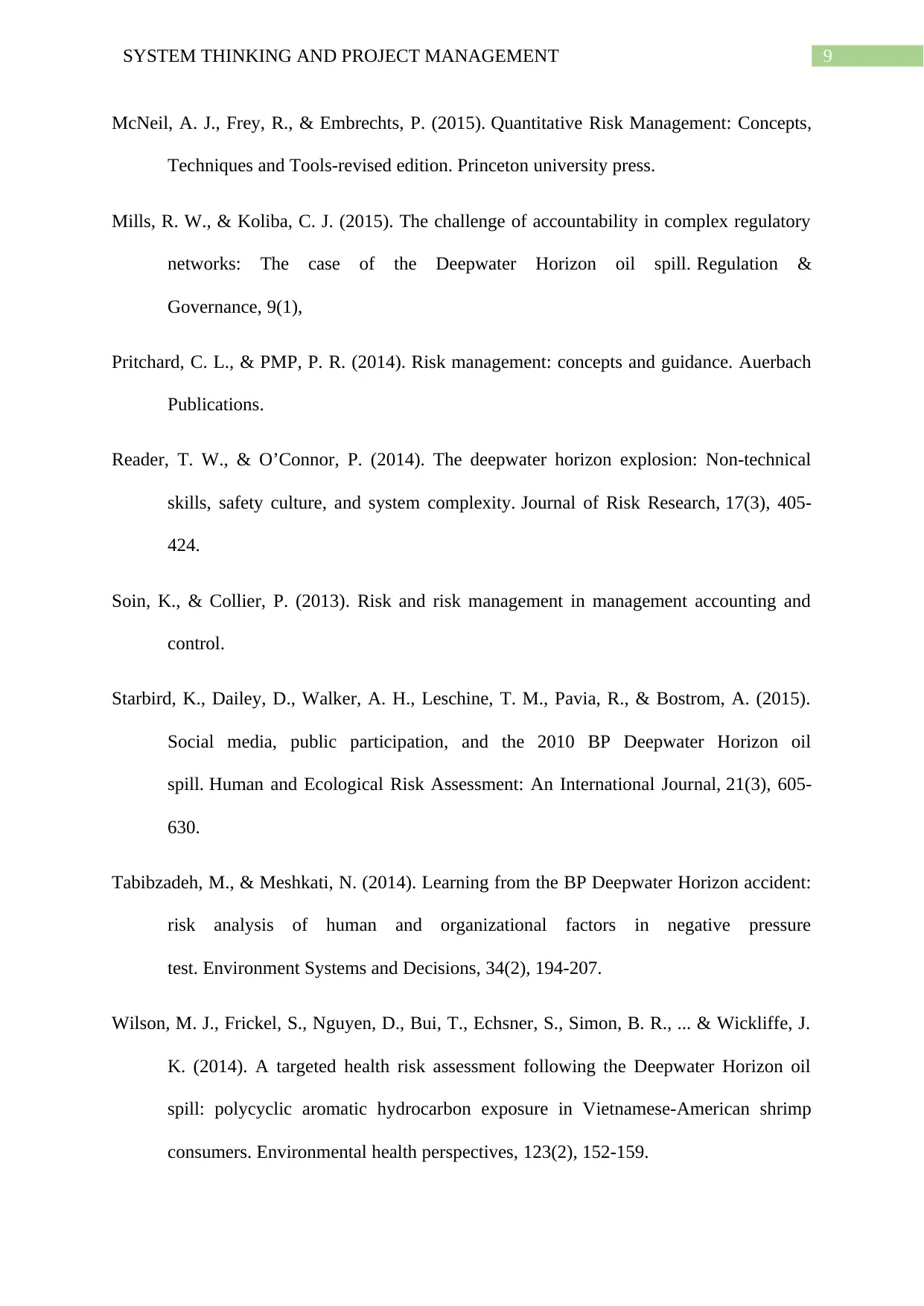
9SYSTEM THINKING AND PROJECT MANAGEMENT
McNeil, A. J., Frey, R., & Embrechts, P. (2015). Quantitative Risk Management: Concepts,
Techniques and Tools-revised edition. Princeton university press.
Mills, R. W., & Koliba, C. J. (2015). The challenge of accountability in complex regulatory
networks: The case of the Deepwater Horizon oil spill. Regulation &
Governance, 9(1),
Pritchard, C. L., & PMP, P. R. (2014). Risk management: concepts and guidance. Auerbach
Publications.
Reader, T. W., & O’Connor, P. (2014). The deepwater horizon explosion: Non-technical
skills, safety culture, and system complexity. Journal of Risk Research, 17(3), 405-
424.
Soin, K., & Collier, P. (2013). Risk and risk management in management accounting and
control.
Starbird, K., Dailey, D., Walker, A. H., Leschine, T. M., Pavia, R., & Bostrom, A. (2015).
Social media, public participation, and the 2010 BP Deepwater Horizon oil
spill. Human and Ecological Risk Assessment: An International Journal, 21(3), 605-
630.
Tabibzadeh, M., & Meshkati, N. (2014). Learning from the BP Deepwater Horizon accident:
risk analysis of human and organizational factors in negative pressure
test. Environment Systems and Decisions, 34(2), 194-207.
Wilson, M. J., Frickel, S., Nguyen, D., Bui, T., Echsner, S., Simon, B. R., ... & Wickliffe, J.
K. (2014). A targeted health risk assessment following the Deepwater Horizon oil
spill: polycyclic aromatic hydrocarbon exposure in Vietnamese-American shrimp
consumers. Environmental health perspectives, 123(2), 152-159.
McNeil, A. J., Frey, R., & Embrechts, P. (2015). Quantitative Risk Management: Concepts,
Techniques and Tools-revised edition. Princeton university press.
Mills, R. W., & Koliba, C. J. (2015). The challenge of accountability in complex regulatory
networks: The case of the Deepwater Horizon oil spill. Regulation &
Governance, 9(1),
Pritchard, C. L., & PMP, P. R. (2014). Risk management: concepts and guidance. Auerbach
Publications.
Reader, T. W., & O’Connor, P. (2014). The deepwater horizon explosion: Non-technical
skills, safety culture, and system complexity. Journal of Risk Research, 17(3), 405-
424.
Soin, K., & Collier, P. (2013). Risk and risk management in management accounting and
control.
Starbird, K., Dailey, D., Walker, A. H., Leschine, T. M., Pavia, R., & Bostrom, A. (2015).
Social media, public participation, and the 2010 BP Deepwater Horizon oil
spill. Human and Ecological Risk Assessment: An International Journal, 21(3), 605-
630.
Tabibzadeh, M., & Meshkati, N. (2014). Learning from the BP Deepwater Horizon accident:
risk analysis of human and organizational factors in negative pressure
test. Environment Systems and Decisions, 34(2), 194-207.
Wilson, M. J., Frickel, S., Nguyen, D., Bui, T., Echsner, S., Simon, B. R., ... & Wickliffe, J.
K. (2014). A targeted health risk assessment following the Deepwater Horizon oil
spill: polycyclic aromatic hydrocarbon exposure in Vietnamese-American shrimp
consumers. Environmental health perspectives, 123(2), 152-159.
Paraphrase This Document
Need a fresh take? Get an instant paraphrase of this document with our AI Paraphraser

10SYSTEM THINKING AND PROJECT MANAGEMENT
1 out of 11
Related Documents
Your All-in-One AI-Powered Toolkit for Academic Success.
+13062052269
info@desklib.com
Available 24*7 on WhatsApp / Email
![[object Object]](/_next/static/media/star-bottom.7253800d.svg)
Unlock your academic potential
Copyright © 2020–2025 A2Z Services. All Rights Reserved. Developed and managed by ZUCOL.




